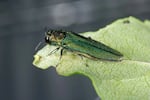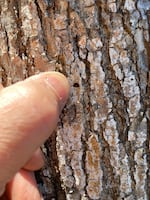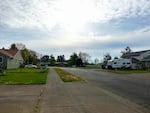The emerald ash borer, a metallic green beetle about a half-inch long, has killed millions of ash trees across the country, and now the invasive insect is killing trees in Oregon.

This undated photo shows the side view of an adult emerald ash borer. The invasive beetle is native to Asia and has killed more than 100 million ash trees in the U.S. since its arrival in 2002. It was first detected in Oregon in Forest Grove in June 2022.
James E. Zablotny/USDA APHIS
This week, crews removed dozens of infested ash trees in Forest Grove as part of a state plan to slow the spread of the destructive pest. This month, state agencies removed 80 infected ash trees from the area.
Experts say there’s no hope of stopping the emerald ash borer invasion that was first discovered in Oregon in 2022. The beetle was first detected in the U.S. in 2002 in Michigan and has since killed hundreds of millions of ash trees in the Midwest and on the East Coast.
“We know we’re not going to eradicate it,” Jim Gersbach with the Oregon Department of Forestry said. “The best hope is to slow the spread.”
Eventually, the emerald ash borer invasion could wipe out the only ash species native to the Pacific Northwest, the Oregon ash, and the effects of that loss could be devastating.
Cutting down the infested ash trees and chipping them up into pieces that are at least 1-inch square is the first part of the state’s plan to slow the invasion. Next month, officials plan to treat healthy ash trees in Washington County with injections of the systemic insecticide emamectin benzoate.
The city of Portland’s tree inventory has identified 94,000 ash trees across all property types, which means about 1% of the city’s trees are susceptible to emerald ash borer infestation with 9,000 ash trees along streets and 16,575 ash trees on residential property.
Max Ragozzino, biological control entomologist with Oregon Department of Agriculture, said state agencies have surveyed more than 6,500 trees near the site of the initial emerald ash borer discovery in Forest Grove and found 190 infested ash trees that will need to be removed and replaced with a different species.

A D-shaped exit hole indicates an emerald ash borer infestation on an ash tree in this undated photo taken in Forest Grove, Ore.
Courtesy of Dominic Maze
Emerald ash borer larvae eat the inside of the tree and restrict its ability to transport nutrients and water until the tree dies, usually within five years of infestation. The metallic green beetles leave a D-shaped exit hole when they leave the tree.
“As a tree is being attacked by the emerald ash borer, it actually girdles the tree, and the tree is completely cut off from any sap flow,” Ragozzino said. “The same way that cutting a ring around a tree would kill it, that’s what the emerald ash borer is doing under the bark.”
To identify a tree that has been infested by this beetle, he said, look for small, D-shaped holes in the bark and larger cracks, as well as dead branches that aren’t producing leaves.
Trees infested with emerald ash borer get brittle as they die and become a fall risk, according to Lilah Gonen, community assistance forester with the Oregon Department of Forestry. That means on some streets, a lot of trees need to be cut down and replaced with a different species.

Before removal: Ash trees infested with the emerald ash borer beetle on a residential street in Forest Grove in late April 2024.
Courtesy of the Oregon Department of Forestry

After removal: State agencies coordinated to take out dozens of trees from this street in Forest Grove this week to slow the spread of the invasive emerald ash borer beetle.
Courtesy of the Oregon Department of Forestry
“It’s devastation,” Gonen said. “It’s the worst news you can receive about your urban forest. ... I think it came sooner than people expected because the closest population we knew of was in Colorado. The goal is to keep it as contained as possible for as long as possible, and to treat trees that are good candidates for treatment to keep them alive as long as possible.”
The beetle has a very fast reproductive cycle, and in other places, it has wiped out huge portions of the tree canopy within five to seven years of infestation.
“We’re trying to avoid that through proactive management,” Gonen said. “Plenty of places have been able to keep some of their ash trees through treatment.”
Gonen said the emerald ash borer infestation probably isn’t limited to Washington County but the state hasn’t confirmed its presence anywhere else in Oregon yet.
Officials suspect the invasive species got to Oregon by someone transporting firewood from out of state. To control the spread of the invasion in Oregon, people should avoid moving firewood long distances, limiting any transportation to within 10 to 30 miles.
The loss of native Oregon ash to the emerald ash borer will be hard on threatened and endangered fish species that depend on the habitat they provide along Oregon’s waterways.
“Our native Oregon ash is a riparian wetland tree species,” Gonen said. “They provide a lot of shade along our waterways, they keep temperatures down and provide habitat for salmon and trout. If we lose all the ash in those riparian areas, we can do some serious damage to our fish populations.”
While most ash trees along streets and residential areas can be replaced with other species such as oak, Gonen said it’s harder to find replacements for the Oregon ash trees because they are uniquely adapted to waterlogged wetlands that dry up in the summer.
“Not many of our other trees can handle those conditions,” Gonen said. “So it’s actually going to be a bit of a challenge.”
Oregon State University Extension Service has a guide for identifying ash trees and the signs and symptoms of the emerald ash borer. Anyone who suspects a tree is infested can take diagnostic photos and report it to the Oregon Invasive Species Hotline. For an assessment of ash trees, contact an arborist who is certified by the International Society of Arboriculture who can recommend protective pesticide treatment by a licensed pesticide applicator if it is needed.
The Oregon Department of Agriculture has imposed a quarantine of all ash material in Washington County to help control the spread of the emerald ash borer.
